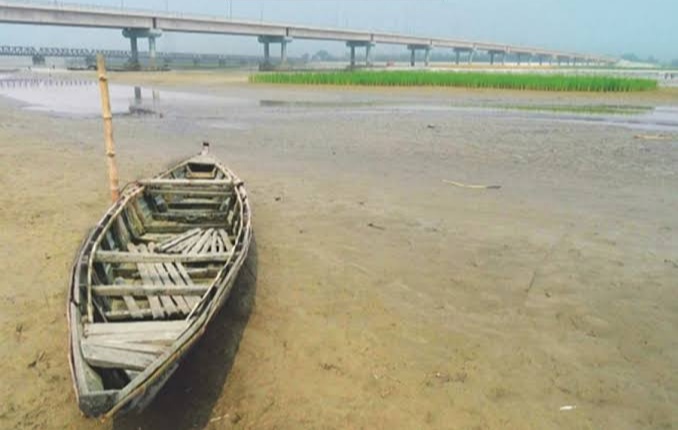Staff Correspondent
Published:2025-04-10 16:20:41 BdST
81 rivers vanishing across Bangladesh: Study
Bangladesh's rivers are in the grip of an alarming ecological crisis, with 81 reported to have dried up during the lean season, according to a recent study.
Once the lifelines of the nation—sustaining local economies, biodiversity, and ecosystems—many rivers are now either heavily silted or vanishing altogether, warns the study titled "Dried-up Rivers of Bangladesh" by the River and Delta Research Centre (RDRC).
The crisis is particularly severe in regions such as Khulna, Satkhira, Rajshahi and Kushtia, where pollution, sedimentation, and rapid urbanisation have severely disrupted natural water flows.
“This deterioration poses a serious threat to livelihoods, agriculture, and biodiversity, underscoring the vital role rivers play in sustaining both ecosystems and human communities,” the study said.
According to the RDRC, the highest number of drying rivers—25—are in Khulna division, followed by 20 in Rajshahi, 15 in Rangpur, six in Chattogram, five in Mymensingh, four in Dhaka, and three each in Barishal and Sylhet divisions.
The list of 81 affected rivers includes the Alay, Atrai, Bagboti, Bangali, Baral, Betna, Bhairab, Bhodrabati, Bhola, Bhulli, Bilash, Burikhora, Chandana, Chandrabati, Chiknai, Chitra, Chuna, Dhalai, Dhaleshwari, Dharla, Dhepa, Dudhkumar, Fotki, Galghesiya, Gangnai, Ghaghat, Gomati, Goneshwari, Gorai and Gumani.
Also affected are the Hanu, Harihar, Hishna, Hoja, Hura Sagor, Ichamoti, distributaries of the Jamuna, Kahua, Kakshiali, Kaliganga, Kalpani, Karatoya, Katakhali, Khakdon, Kholpetua, Kohelia, Kopotakkho, Kulik, Kumar, Kushiyara, Mahananda, Manash, Mathavanga, Mohishaban, Morrichap, Moyur, Muhuri, and Muradiya.
The remaining rivers are Nabaganga, Nagar, Narod, Noroshunda, some distributaries of the Padma, Pagla, Punarbhaba, Sandha, Selonia, Shagorkhali, Shalikha, Shib, Sholmari, Shuk, Someshwari, Sonai, Sukhdah, Surma, Tangon, Teesta, Titash, Tulsi Ganga, and Lenga.
The study highlights growing concern for the Brahmaputra-Jamuna-Meghna (BGM) basin, which is under severe stress due to upstream dams and water diversions. These are disrupting the natural flow and affecting millions of people dependent on these rivers for fishing, farming and transportation.
“As water levels become unpredictable, entire communities are struggling. The impact goes beyond humans—it’s damaging wildlife, destroying habitats, and disrupting the natural balance,” it noted.
The RDRC recommends immediate action to reduce pollution, prevent erosion, and restore aquatic ecosystems. But, the study emphasises that national efforts alone are insufficient.
“Given that many rivers cross international borders, Bangladesh must engage in regional cooperation with upstream countries. Only through joint efforts can we ensure these rivers continue to sustain people and nature for generations to come,” the report said.
With over 24,000 kilometres of rivers, canals and streams, Bangladesh is home to one of the world’s largest natural river networks.
During the monsoon, approximately 6,000 kilometres remain navigable. That figure drops to just 3,800 kilometres in the dry season.
Unauthorized use or reproduction of The Finance Today content for commercial purposes is strictly prohibited.


